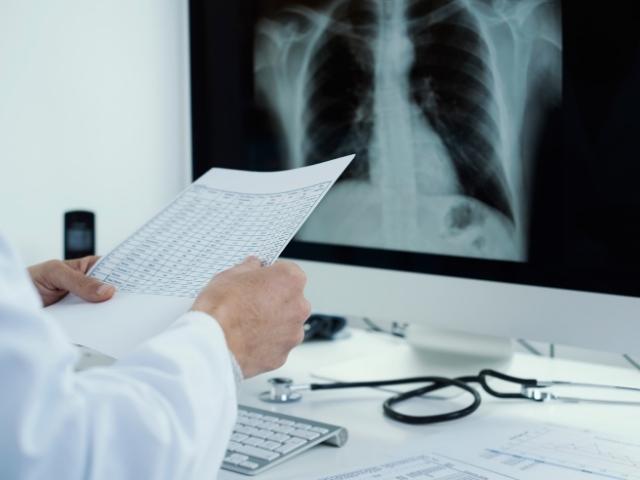- 374-C, Amrapali Circle, Vaishali Nagar, Jaipur
Thoracic Oncology
Thoracic Oncology
Lung cancer is a condition characterized by the uncontrolled growth of abnormal cells in the lungs, which fail to function as normal lung cells and do not contribute to the development of healthy lung tissue. These abnormal cells rapidly divide and form tumors in both lungs, which can spread to other parts of the body if left undetected and untreated. When tumors are confined to a single location in the lung and do not spread, they are generally considered benign. However, if tumors spread to other parts of the body through the bloodstream or lymphatic system, they are classified as malignant. Malignant tumors can be more difficult to treat, and typically do not develop in healthy lung tissue. Common risk factors for lung cancer include exposure to radon, air pollution, certain chemicals in the workplace, active or passive smoking, and a family history of lung cancer.
Lung cancer is a major cause of cancer-related deaths among both men and women. In fact, it claims more lives each year than breast, ovarian, and prostate cancers combined.


Types of Lung Cancer
Based on the appearance of lung cancer cells under the microscope, lung cancer can be classified into two main types.
The first type is non-small cell lung cancer (NSCLC), which is a term that encompasses several subtypes of lung cancer that behave in a similar way. This type of cancer includes squamous cell carcinoma, adenocarcinoma, and large cell carcinoma. NSCLC is relatively insensitive to chemotherapy compared to the second type of lung cancer.
The second type is small cell lung cancer (SCLC), which is more common in both males and females. SCLC is known to grow and spread faster than NSCLC, making it less likely to be cured with treatment but more likely to respond to chemotherapy.
Symptoms of Lung Cancer
The symptoms of Non-small cell lung cancer and Small cell lung cancer are quite similar, with early signs often including chest pain that worsens during deep breathing, laughing, or coughing; a persistent cough; coughing up phlegm or blood in small amounts; fatigue; loss of appetite; shortness of breath; wheezing; bone pain; headache; unexplained weight loss; and, in some cases, recurrent respiratory infections such as pneumonia or bronchitis. As the cancer spreads, additional symptoms may arise, depending on the location of the new cancer. Tumors at the top of the lungs can affect the facial nerves, leading to drooping of one eyelid, a small pupil, or a lack of perspiration on one side of the face, which are collectively known as Horner's syndrome. This may also cause shoulder pain.
Diagnosis of Lung Cancer
If a patient is suspected to have lung cancer, a doctor may recommend various screening procedures to diagnose the condition. These may include imaging tests such as X-rays, CT scans, and PET scans, as well as sputum cytology and tissue samples (biopsies).
Imaging tests can provide detailed images of the lungs, revealing any abnormal masses or lesions. A CT scan can detect smaller lesions that may not be visible on an X-ray. Sputum cytology involves examining phlegm for the presence of lung cancer cells. Tissue samples can be obtained through various methods, including bronchoscopy, mediastinoscopy, and needle biopsy.
Treatment options for lung cancer may include surgery, chemotherapy, targeted agents, immunotherapy, and radiation therapy. The choice of treatment depends on various factors such as the stage and type of cancer, the patient's overall health, and other individual factors.
Treatment of Lung Cancer
Lung cancer treatment options include surgery, chemotherapy, and radiation therapy. The surgical options depend on the type and size of cancer. Chemotherapy is used to kill cancer cells and can be given orally or intravenously. Radiation therapy uses high-powered energy beams to kill cancer cells and can be given externally or internally. Advanced surgical techniques such as minimally invasive surgery and video-assisted thoracoscopic surgery (VATS) are available. Upgraded and precisely targeted radiation therapy techniques can be more effective and cause fewer side effects.
Targeted Therapy
The understanding of lung cancer is rapidly evolving, especially in non-curable cases where the genetic and molecular abnormalities of the cancer cells are analyzed to identify treatments that block the abnormal pathways responsible for the cancer's growth. These treatments are often oral and less harsh than chemotherapy, making them a good long-term option for patients. Immunotherapy is a field of oncology that has significantly impacted lung cancer treatment and was even awarded a Nobel Prize in 2018. While it can be effective in making stage 4 cancers disappear and keeping them at bay for years, it is not suitable for everyone and has unique side effects. Only experts should determine if it is the best treatment option and how to manage its effects.
What We Do
At Amar Jain Hospital, we treat around 500 patients with thoracic cancers every year. Our hospital located in Saket has a team of certified and trained oncologists who provide comprehensive cancer care services. We offer treatment for various thoracic cancers, including esophageal cancers, lung cancers, chest wall tumors, mesotheliomas, mediastinal tumors, and pulmonary and pleural metastases. Each patient is discussed in dedicated thoracic tumor boards, which offer the benefit of multi-disciplinary input in their management. We also integrate genetic and molecular information in our treatments to offer personalized and precise care. Our hospital actively participates in multicenter clinical trials and research for thoracic cancers. We provide patient-centered care with dedicated staff to support the psychological and social needs of patients and their families.
